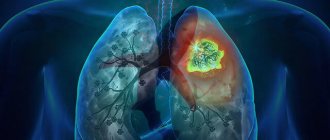What does the outcome depend on?
— Mikhail Petrovich, Nadezhda Olegovna, is there a worldwide problem of pulmonary fibrosis? Is this issue being discussed anywhere else besides Russia?
MK: The “frosted glass” effect (the manifestation of processes in the lungs in which a decrease in the density of lung tissue occurs - Ed.) was discovered by the Chinese. This means that we were not the first to begin to deal with the problem of pneumofibrosis - specific changes in the lung tissue that impair breathing after an illness.
NK: A lot of information comes from different countries that pulmonary fibrosis is reversible. Sometimes we see this in the clinic too. Of course, the patients are completely different, but we proceed from the damage to the lung tissue that occurred during the disease and what it resulted in later.
MK: There is a problem, but the disease has a favorable outcome, which depends on many factors.
— What is the danger of the disease and when is the outcome favorable?
MK : The outcome of pulmonary fibrosis may depend on the person’s age, the severity of the disease, timely prescribed treatment, the person’s immune system, his chronic pathology of the bronchopulmonary system, autoimmune diseases and other factors. Therefore, if we take a lung lesion of approximately 15% in a young person who is on his feet, and the same lesion in a person who is over 40 or 60 and who has a lot of other diseases, we will see different outcomes from each other. The reasons for the regression of the inflammatory process are also directly related to the human immune system and the treatment of pulmonary fibrosis, as well as further rehabilitation. This is a long process; it may not be limited to a month, but may drag on for two, three, or even more.
The recovery process should be led by a pulmonologist or therapist. The correct sequence of actions and a sufficient list of studies are important, which is associated with the choice of a specific treatment tactic, including not only medication methods. Now in the West, in this regard, they talk about physiotherapy, ultrasound, exercise therapy, swimming, walking, massages, etc.
NK: Conditionally, patients can be divided into those who have small foci of pulmonary fibrosis, when neither hospitalization nor interventions are required, because there is a high probability that the fibrosis will regress, and those with moderate and severe (from 25% - Ed .) damage to the lung tissue, when different courses are possible. We see such patients. They require respiratory support, and rehabilitation can last six months.
There are also patients with a prolonged course - up to 8 months - some of them are prescribed oxygen concentrators as temporary palliative care. Such people require treatment in a hospital, where they undergo an acute period, and fibrosis, as we see from computed tomography (CT), still resolves.
Symptoms of pulmonary fibrosis
At the initial stage, the disease manifests itself as general weakness and increased fatigue. Patients experience pale skin with a bluish tint, especially in the nasolabial triangle, nose and limbs. Many patients report drowsiness during the day and insomnia at night, as well as unmotivated weight loss.
Then shortness of breath joins the above complaints. At the beginning, it bothers the patient only during physical activity, but as the pathology progresses, it begins to occur at rest.
Some patients have a dry or wet, unproductive cough. In the second case, a scant amount of viscous mucous sputum is detected. The appearance of purulent discharge indicates the addition of a secondary bacterial infection.
In patients suffering from pulmonary fibrosis for a long time, there is a change in the shape of the nails, which become like “watch glasses” and the terminal phalanges of the fingers like “drumsticks”.
At the peak of the disease, heart failure occurs, manifested by peripheral edema, palpitations, arrhythmia, pulsation of the neck veins, and severe shortness of breath at rest.
Not just the lungs
— Why is pulmonary fibrosis dangerous?
MK: The trouble is that not only the lungs suffer from lung disease. It is known that when oxygen supply is limited, if gas exchange does not occur, complications in the functioning of the cardiovascular and nervous systems subsequently arise. The heart begins to work harder: deformation appears, various pathologies are formed throughout the cardiovascular system, since lung damage does not occur separately from vascular damage. And then - increased pressure with possible hypertension, and blood clots may also break off.
Then a nervous rollback begins, because depression develops from a lack of oxygen, and people simply lose the desire to live. Memory fails: a person may be asked to leave work because labor productivity is falling. If left untreated, this condition may not be limited to 6 months or a year, but will persist forever.
The process of rehabilitation of such patients is a new direction, we must now develop and develop it. Psychologists, cardiologists, neurologists, and endocrinologists will have to work here.
Prognosis of pneumofibrosis
Pneumofibrosis is always a consequence of the underlying disease and the prognosis in this case depends on the severity and complexity of the initial disease. With significant damage to the lung tissue, a decrease in lung volume occurs, which leads to respiratory failure and increased pressure in the pulmonary artery. Death, as a rule, occurs as a result of a new infection or the onset of the tuberculosis process.
Pneumofibrosis disrupts the structure and function of the lungs. Over time, the pathology leads to deformation of the bronchi, a decrease in volume and shrinkage of the lungs. All age categories are susceptible to the disease; most often, pneumofibrosis is diagnosed in men.
Difficulty of diagnosis
— Is there any difficulty in diagnosing pulmonary fibrosis, how can it be suspected and complications prevented?
MK: Difficulty always exists because not every patient is given a differential diagnosis. It happens that when studying lung damage, a disease is accidentally revealed that was not previously noticed.
NK: It is necessary to diagnose pulmonary fibrosis, and take into account that the patient may never have undergone a CT scan in his life. Or maybe he even had some respiratory symptoms in the form of shortness of breath, decreased exercise tolerance, etc., but he did not pay attention. Then you need to contact a therapist or pulmonologist.
MK: If the patient knows his diseases, then it is necessary to observe them over time. I know young people who first developed asthma against this background. And all because a trigger mechanism arose. And if there is an allergic altered reactivity, then it worsens.
— Are there recommendations for the management of patients with pulmonary fibrosis?
MK: I can’t fully say about the officially recognized ones. The main thing is that we now need to act in such a way that treatment is the same throughout all of Russia and that they know what methods are available for studying those patients who have suffered pulmonary diseases.
Already last spring, at the height of the pandemic, doctors asked if we had any programs for medical examination of such patients, i.e. the request in practice was ahead of the recommendations that came out later. I believe that such recommendations should become the standard.
NK: As far as I know, there is a manual for the rehabilitation of patients after COVID-19. And for pulmonary fibrosis, antifibrosis therapy is recommended and actually actively used (it comes in the form of suppositories or injections).
Prevention
A person who, due to the nature of his work, often comes into contact with pneumotoxic substances, must strictly adhere to safety rules. Dust and hazardous gases are always present in mines and other industrial processes. All these premises must have ventilation, and workers must use respirators.
Also, the condition of patients with pulmonary fibrosis is improved by complete cessation of smoking, hardening and physical exercise.
- invasive and infectious diseases (pneumonia, also those that could develop after tuberculosis, syphilis, mycoses, and so on);
- obstructive chronic pathologies;
- limited (local) is a dense area of lung tissue in which the pathology is not very pronounced. Local pulmonary fibrosis does not greatly affect the mechanical properties of lung tissue and their gas exchange functions;
- diffuse pneumofibrosis is a condition when the lungs are compacted, reduced in volume and have a disrupted normal structure. Complete ventilation of the lungs in the case of diffuse disease is significantly reduced.
Therapy - if indicated
— Which patient can and should suspect that he or she has pulmonary fibrosis?
NK: It depends on the focus of the pulmonary lesion. A small focus of pneumofibrosis, of course, does not manifest itself clinically. If this is a more extensive damage to the lung tissue (from 25%), then a decrease in exercise tolerance, the development of shortness of breath, cough, and a decrease in oxygen saturation in the blood are possible. Then, of course, you can suspect a problem and perform a CT scan to confirm the diagnosis.
MK: When you stop at every flight of stairs while walking or climbing stairs, you feel like you’re not getting enough air
— At what stage is it better to use therapy against pulmonary fibrosis?
NK: If indicated. If, after studying pulmonary function, performing a CT scan, and excluding a predisposition to thrombus formation, there are indications that therapy is necessary, of course, it is carried out.
MK: Criteria for assessing the severity and damage to the bronchopulmonary system must be developed. And a single step-by-step approach, because after the examination some patients will be treated on an outpatient basis, some in a hospital, and some in a mixed manner.
There must be specific prevention of the release of hyaluronic acid into the bronchopulmonary apparatus. Drugs are prescribed that can inhibit its further release, so that new painful areas do not form in the lungs. And there are such drugs in Russia.
Studies have shown that the administration of an antifibrotic drug (for example, bovhyaluronidase azoximer) has an inhibitory effect, preventing the disease from spreading towards severe pulmonary fibrosis. This drug is prescribed for both the treatment and prevention of pulmonary fibrosis.
I am sure that in the next six months new Russian recommendations will appear that will show what methods and drugs can and should be prescribed for pulmonary fibrosis with a risk of its development. But while new techniques are being developed, we will not be able to abandon the patients: we will use what we know, which can have an impact on the restoration of lung tissue.
Reasons for the development of pathology
There are many causes for the development of pulmonary fibrosis. These include:
- Diseases of the respiratory system (COPD, pneumonia, tuberculosis).
- Systemic connective tissue diseases (scleroderma, SLE, rheumatoid arthritis).
- Taking a number of medications (cytostatics, antiarrhythmic drugs).
- Vasculitis of various origins.
- Harmful production factors (asbestos, silicates, etc.).
Idiopathic pulmonary fibrosis is also isolated when the cause of the pathological process cannot be determined.
Folk remedies
Photo: narodnimisredstvami.ru
First of all, measures should be taken to prevent the development of pulmonary fibrosis. In many cases, pulmonary fibrosis is caused by diseases of the respiratory system, in particular pneumonia, which can lead to the replacement of lung tissue with connective tissue in the absence of treatment, the patient’s self-cancellation of antibacterial therapy, or failure to follow doctor’s recommendations. Therefore, it is extremely important, when the first symptoms of the disease appear, not to neglect your condition, but to consult a specialist and strictly follow his instructions. In addition, diseases such as chronic bronchitis with the phenomenon of bronchial obstruction, bronchiectasis of the lungs, chronic obstructive pulmonary disease, with a long course of the process, can also lead to the development of fibrosis. Considering this, it is important to avoid factors whose impact on the body leads to an exacerbation of the process. For the same purpose, annual influenza vaccination is recommended. People who are forced to use antiarrhythmic drugs for a long time need to be attentive to the appearance of symptoms from the respiratory system. If they are detected, you should immediately seek help from a doctor, and it is strongly recommended not to forget about an annual chest x-ray examination.
Special attention should be paid to people working in industries with occupational hazards. Long-term inhalation of organic and inorganic dust leads to the development of lung diseases, ultimately leading to fibrosis. Therefore, you should not neglect safety precautions, in particular the use of special devices that protect the upper parts of the respiratory system.
Traditional medicine recipes help to some extent alleviate the general condition of a person suffering from pulmonary fibrosis. For example, a decoction of rose hips and elecampane root has an excellent effect. To prepare it, grind the listed components, then pour 4 tablespoons of dry raw materials with 4 glasses of water and put on low heat. After boiling, keep it on the fire for another 15 minutes. Then the resulting broth is poured into a thermos and infused for 3 hours, after which it is carefully filtered. It is recommended to take half a glass 3 times a day before meals. The course of treatment is from 1 to 2 months. It is important not to interrupt the course of treatment and always have a ready-made remedy on hand. The combination of rosehip and elecampane helps to liquefy mucus, thereby making it easier to separate. In addition, this decoction protects lung tissue from inflammatory processes.
A recipe using anise seed is also widely used. To prepare this product, you should first prepare 1 tablespoon of anise seeds, which are poured with 1 glass of cold water. The resulting mixture is placed on the fire and brought to a boil, after which it is immediately removed from the stove. It is recommended to use the resulting product half a glass once a day.
The information is for reference only and is not a guide to action. Do not self-medicate. At the first symptoms of the disease, consult a doctor.
SEARCH FOR TREATMENT AROUND THE WORLD WITH YELLMED







